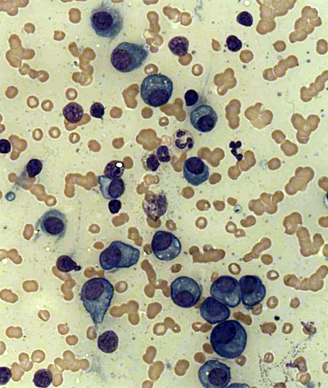Alternative Multiple Myeloma Plasma Cell Surface Markers Identified
Two alternative multiple myeloma plasma cell surface markers have been identified and could be important for subclassification, prognostication, and treatment stratification of patients with multiple myeloma.
Plasma cells in a case of multiple myeloma; source: Dr. Erhabor Osaro.

Two alternative multiple myeloma plasma cell surface markers have been identified, according to the results of a recent study published in Blood. The identification of these two markers, CD319 and CD269, are important for subclassification, prognostication, and treatment stratification of patients with multiple myeloma.
“Molecular characterization of malignant plasma cells is increasingly important for diagnostic and therapeutic stratification in multiple myeloma. However, the malignant plasma cells represent a relatively small subset of bone marrow cells, and need to be enriched prior to analysis,” wrote researchers led by Ildikó Frigyesi, MSc, of Lund University, Sweden, and colleagues. “Currently, the cell surface marker CD138 (SDC1) is used for this enrichment, but has an important limitation in that its expression decreases rapidly after sampling.”
The researchers sought to identify alternative multiple myeloma plasma cells surface markers by doing a computational screen based on sets of gene expression microarray data. They used the gene expression profiles of 1,285 fresh and frozen multiple myeloma samples and 3,164 samples of other hematologic malignancies as a control data set.
The researchers identified seven candidate multiple myeloma plasma cells markers: TNFRSF17, SLAMF7, GPRC5D, FKBP11, KAMP3, ITGA8, and FCRL5. Two methods of evaluation were used. First, the researchers mimicked the common clinical situation by quantifying protein levels in bone marrow aspirates in samples that had been stored for 1 to 3 days. Second, they mimicked biobanking by analyzing protein levels in samples that were vital-frozen.
“Throughout, CD319, CD269, and CD307e defined discrete cell populations (and co-stained with CD138 in fresh samples), whereas CD208, GPRC5D, ITGA8, and FKBP11 could not be detected with the available antibodies,” the researchers wrote.
When the researchers tested for these markers in a larger number of samples, CD319 and CD269 were consistently found in cell populations in delayed and frozen samples. In contrast, levels of CD138 varied between samples and were lower in delayed and frozen samples compared with fresh samples. CD319 and CD269 were identified even in samples where CD138-positive cells were not.
“To confirm that the identified cell populations were multiple myeloma plasma cells, we isolated CD319-positive and CD269-positive cells in selected samples by fluorescence-activated cell sorting,” the researchers wrote. “Marker-positive cells showed multiple myeloma plasma cells morphology, clonal excess, and myeloma-associated gains or losses of chromosomal material by DNA copy number microarray.”
Next, the researchers tested identification of each of these markers over time. Five samples were stained for CD138, CD269, and CD319 at time points between 0 and 40 hours of storage. Four out of five samples showed a decrease in CD318. However, CD319 staining was persistent in all cases and CD269 persisted in four of five cases.
“We show that CD319 and CD269 enable isolation of multiple myeloma plasma cells under substantially more diverse conditions than the current standard marker CD138,” the researchers wrote. “Our results identify CD319 and CD269 as robust replacements for CD138, and point the way to improved procedures (eg, novel magnetic bead-based purification protocols) for analyzing multiple myeloma plasma cells in clinical practice.”
Navigating AE Management for Cellular Therapy Across Hematologic Cancers
A panel of clinical pharmacists discussed strategies for mitigating toxicities across different multiple myeloma, lymphoma, and leukemia populations.